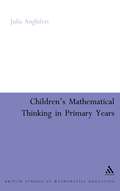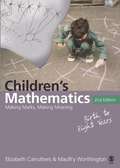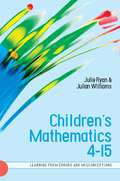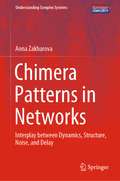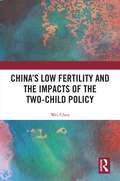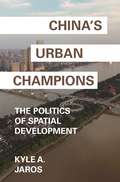- Table View
- List View
Children's Errors in Mathematics (Transforming Primary QTS Series)
by Alice Hansen Doreen Drews John Dudgeon Fiona Lawton Liz SurteesThis practical and popular guide to children&’s common errors and misconceptions in primary mathematics is an essential tool for teachers and trainees. It supports them in planning for and tackling potential errors and enhances their understanding of the difficulties encountered in mathematical development. Providing guidance on how to identify common misconceptions, it explores how common misconceptions can be anticipated and addressed. What's new to this edition? New introductory chapter exploring contemporary themes and approaches being used in primary classrooms and schools today, such and Singapore and Shanghai maths. More content on mastery approaches to teaching mathematics, exploring &‘what is mastery&’? Support around preparing children for new statutory times tables test with new content and a deeper exploration of children&’s errors in multiplication. More intervention strategies. New scenarios section.
Children's Errors in Mathematics
by Alice Hansen Doreen Drews Fiona Lawton John Dudgeon Liz SurteesThis practical guide to children’s common errors and misconceptions in mathematics is a popular planning tool for primary trainees. It supports a deeper understanding of the difficulties encountered in mathematical development. This third edition has been updated to link to the new National Curriculum. New for this edition is a chapter on addressing errors misconceptions which explores how errors can best be identified and countered. The text examines misconceptions individually and in each case provides a description of the error alongside an explanation of why the error happens. The text also considers the role of the teacher in understanding and addressing children’s common mathematical misconceptions.
Children's Errors in Mathematics
by Alice Hansen Doreen Drews Fiona Lawton John Dudgeon Liz SurteesThis practical and popular guide to children’s common errors and misconceptions in primary mathematics is an essential tool for teachers and trainees. It supports them in planning for and tackling potential errors and enhances their understanding of the difficulties encountered in mathematical development. This fourth edition explores how a Growth Mindset approach works alongside an awareness of children's errors and how mistakes themselves are powerful learning tools. This edition includes 50 new identifiable misconceptions children have of mathematics. The text also considers the role of the teacher in understanding and addressing children’s common mathematical misconceptions. Key features: Linked to the new National Curriculum and covers every objective Provides an essential tool for planning primary mathematics lessons Explores how common misconceptions can be anticipated and addressed
Children's Errors in Mathematics: Understanding Common Misconceptions (PDF)
by Liz Surtees Doreen Drews Fiona Lawton John DudgeonThis practical guide to children's common errors and misconceptions in mathematics is ideal for anyone training to teach 4-11 year old children and keen to gain a deeper understanding of the difficulties children encounter during their mathematical development. The book is structured around National Curriculum Attainment Targets, and deals with individual misconceptions, in each case providing a description of the error, and an explanation of why the error happens.
Children's Errors in Mathematics (2nd edition) (PDF)
by Alice HansenThis practical guide to children's common errors and misconceptions in mathematics is ideal for primary trainees, helping them gain a deeper understanding of the difficulties encountered in mathematical development. This Second Edition has been fully revised and all links to the EYFS and the Revised Primary Framework have been updated. New research and literature are included, additional errors are considered, and using and applying mathematics is fully embedded throughout. Individual misconceptions are dealt with and in each case a description and explanation of the error is provided. The teacher's role in understanding and addressing common misconceptions is also covered.
Children's Errors in Mathematics (PDF)
by Alice Hansen Doreen Drews Fiona Lawton John Dudgeon Liz SurteesThis practical guide to children’s common errors and misconceptions in mathematics is a popular planning tool for primary trainees. It supports a deeper understanding of the difficulties encountered in mathematical development. This third edition has been updated to link to the new National Curriculum. New for this edition is a chapter on addressing errors misconceptions which explores how errors can best be identified and countered. The text examines misconceptions individually and in each case provides a description of the error alongside an explanation of why the error happens. The text also considers the role of the teacher in understanding and addressing children’s common mathematical misconceptions.
Children's Errors in Mathematics (PDF)
by Alice Hansen Doreen Drews Fiona Lawton John Dudgeon Liz SurteesThis practical and popular guide to children’s common errors and misconceptions in primary mathematics is an essential tool for teachers and trainees. It supports them in planning for and tackling potential errors and enhances their understanding of the difficulties encountered in mathematical development. This fourth edition explores how a Growth Mindset approach works alongside an awareness of children's errors and how mistakes themselves are powerful learning tools. This edition includes 50 new identifiable misconceptions children have of mathematics. The text also considers the role of the teacher in understanding and addressing children’s common mathematical misconceptions. Key features: Linked to the new National Curriculum and covers every objective Provides an essential tool for planning primary mathematics lessons Explores how common misconceptions can be anticipated and addressed
Children's Fractional Knowledge
by Leslie P. Steffe John OliveChildren’s Fractional Knowledge elegantly tracks the construction of knowledge, both by children learning new methods of reasoning and by the researchers studying their methods. The book challenges the widely held belief that children’s whole number knowledge is a distraction from their learning of fractions by positing that their fractional learning involves reorganizing—not simply using or building upon—their whole number knowledge. This hypothesis is explained in detail using examples of actual grade-schoolers approaching problems in fractions including the schemes they construct to relate parts to a whole, to produce a fraction as a multiple of a unit part, to transform a fraction into a commensurate fraction, or to combine two fractions multiplicatively or additively. These case studies provide a singular journey into children’s mathematics experience, which often varies greatly from that of adults. Moreover, the authors’ descriptive terms reflect children’s quantitative operations, as opposed to adult mathematical phrases rooted in concepts that do not reflect—and which in the classroom may even suppress—youngsters’ learning experiences. Highlights of the coverage: Toward a formulation of a mathematics of living instead of being Operations that produce numerical counting schemes Case studies: children’s part-whole, partitive, iterative, and other fraction schemes Using the generalized number sequence to produce fraction schemes Redefining school mathematics This fresh perspective is of immediate importance to researchers in mathematics education. With the up-close lens onto mathematical development found in Children’s Fractional Knowledge, readers can work toward creating more effective methods for improving young learners’ quantitative reasoning skills.
Children's Mathematical Thinking in Primary Years
by Julia AnghileriThis popular Continuum series, intended chiefly for teachers and trainee teachers, places strong emphasis on practice but at the same time incorporates the latest research in the field. The book demonstrates a strong belief in the ability of children to learn, and in the ability of teachers to increase children's learning potential.The series authors are distinguished practitioners in their fields who write with authority, but without jargon.With the increasingly popular constructivist framework for learning, teachers are coming to recognize the limitations of taught procedures and to find ways to encourage children to generate their own knowledge and understanding in mathematics. The challenge for teachers is to promote an environment that encourages mathematical thinking in which pupils of all abilities are able to achieve their full potential. This text brings together experiences of teachers and researchers who examine the ways children work mathematically, in order to provide an enhanced learning environment within the classroom. It also addresses key issues in current maths teaching.
Children's Mathematical Thinking in Primary Years: Perspectives On Children's Learning
by Julia AnghileriThis popular Continuum series, intended chiefly for teachers and trainee teachers, places strong emphasis on practice but at the same time incorporates the latest research in the field. The book demonstrates a strong belief in the ability of children to learn, and in the ability of teachers to increase children's learning potential.The series authors are distinguished practitioners in their fields who write with authority, but without jargon.With the increasingly popular constructivist framework for learning, teachers are coming to recognize the limitations of taught procedures and to find ways to encourage children to generate their own knowledge and understanding in mathematics. The challenge for teachers is to promote an environment that encourages mathematical thinking in which pupils of all abilities are able to achieve their full potential. This text brings together experiences of teachers and researchers who examine the ways children work mathematically, in order to provide an enhanced learning environment within the classroom. It also addresses key issues in current maths teaching.
Children's Mathematics: Making Marks, Making Meaning
by Elizabeth CarruthersVisit the author's own website here! Children's Mathematics Network'In Case Study 5 (a grassroots 'Children's Mathematics Network group') the initiative supported the participants in their professional change by giving them a space for the detailed and joint consideration of children's mathematical thinking. Another significant feature of this initiative is its focus on careful consideration and analysis of children's mathematics, and the ways in which professionals can support and encourage the children's mathematical thinking and reasoning The standard of the mathematical understanding, thinking and reasoning that the displays revealed was far higher than the specified curriculum objectives for children of this age' - Researching Effective CPD in Mathematics Education (RECME) project: (NCETM, 2009) 'The review also plays great score by play-based learning of a mathematical nature, and makes specific recommendations regarding early mark-making as a precursor to abstract mathematical symbolism'. Section 115 features children's mathematical graphics and emphasises: 'The role of mark-making in children's cognitive development is set out in the taxonomy (Carruthers and Worthington, 2006)'. The report recommends that 'local authorities, leaders, managers and head teachers should provide a culture with a significant focus on mathematical mark-making' and 'a learning environment that encourages children to choose to use their own mathematical graphics to support their mathematical thinking and processes' - The Williams Maths Review: (DCSF, 2008) At the very heart of the success of the book is the authors' ability to see mathematics through young children's eyes by listening to and reflecting on the constant efforts made by children to make sense of their world. This is a liberating book which proposes that the teaching of mathematics could and should be a highly creative and enjoyable proceess' - Branwen Llewelyn Jones, Early Years Consultant at PACE Ltd / TACTYC'Ground breaking... To single out any one chapter would be unfair because there is something thought-provoking and inspirational throughout. If you want to expand your understanding upwards and outwards then get a copy soon' - Times Educational Supplement'I first read Children's Mathematics, Making Marks, Making Meaning a couple of years ago and it had an immediate impact on my own thinking and teaching, and the work I do with trainee teachers. I'm sure you will find it compelling reading too. I think it has the potential to change, in a fundamental way, how we think about early mathematical development' - Lynne McClure, Editor, Math Co-ordiator's File, Mathematics Association'In their exceptionally readable and informative book, Children's Mathematics, Making Marks, Making Meaning Carruthers and Worthington (2006) draw attention to one of the main goals of early years teaching, that is, to help children make links between the mathematics they have already encountered (and continue to engage with) at home and the more abstract mathematics of the school. These authors suggest that by encouraging children to represent mathematical ideas in their own ways and, crucially, by talking to the pupils about the marks they have made, we are given a e;windowe; onto their thinking that may otherwise be inaccessible' - Liz Pumphrey, NRICHThis book draws on the authors' many years of teaching children aged three to eight years and also on their extensive research with children in the home, nursery and school. The authors explain the development and range of young children's mathematical marks and visual representations, showing how children make mental connections between their own early marks and subsequent abstract mathematical symbolism, and go on to develop their own written methods. Combining theory and practice, this acclaimed book demonstrates how children's own mathematical graphics are highly creative and show deep levels of thinking. The authors show how this is the key to success in school mathematics and to higher levels of achievement. The authors are winners of TACT...
Children's Mathematics: Making Marks, Making Meaning
by Maulfry Worthington Elizabeth CarruthersVisit the author's own website here! Children's Mathematics Network 'In Case Study 5 (a grassroots 'Children's Mathematics Network group') the initiative supported the participants in their professional change by giving them a space for the detailed and joint consideration of children's mathematical thinking. Another significant feature of this initiative is its focus on careful consideration and analysis of children's mathematics, and the ways in which professionals can support and encourage the children's mathematical thinking and reasoning… The standard of the mathematical understanding, thinking and reasoning that the displays revealed was far higher than the specified curriculum objectives for children of this age…' - Researching Effective CPD in Mathematics Education (RECME) project: (NCETM, 2009) 'The review also plays great score by play-based learning of a mathematical nature, and makes specific recommendations regarding early mark-making as a precursor to abstract mathematical symbolism'. Section 115 features children's mathematical graphics and emphasises: 'The role of mark-making in children's cognitive development is set out in the taxonomy (Carruthers and Worthington, 2006)'. The report recommends that 'local authorities, leaders, managers and head teachers should provide a culture with a significant focus on mathematical mark-making' and 'a learning environment that encourages children to choose to use their own mathematical graphics to support their mathematical thinking and processes' - The Williams Maths Review: (DCSF, 2008) `At the very heart of the success of the book is the authors' ability to see mathematics through young children's eyes by listening to and reflecting on the constant efforts made by children to make sense of their world. This is a liberating book which proposes that the teaching of mathematics could and should be a highly creative and enjoyable proceess' - Branwen Llewelyn Jones, Early Years Consultant at PACE Ltd / TACTYC 'Ground breaking... To single out any one chapter would be unfair because there is something thought-provoking and inspirational throughout. If you want to expand your understanding upwards and outwards then get a copy soon' - Times Educational Supplement 'I first read Children's Mathematics, Making Marks, Making Meaning a couple of years ago and it had an immediate impact on my own thinking and teaching, and the work I do with trainee teachers. I'm sure you will find it compelling reading too. I think it has the potential to change, in a fundamental way, how we think about early mathematical development' - Lynne McClure, Editor, Math Co-ordiator's File, Mathematics Association 'In their exceptionally readable and informative book, Children's Mathematics, Making Marks, Making Meaning Carruthers and Worthington (2006) draw attention to one of the main goals of early years teaching, that is, to help children make links between the mathematics they have already encountered (and continue to engage with) at home and the more abstract mathematics of the school. These authors suggest that by encouraging children to represent mathematical ideas in their own ways and, crucially, by talking to the pupils about the marks they have made, we are given a "window" onto their thinking that may otherwise be inaccessible' - Liz Pumphrey, NRICH This book draws on the authors' many years of teaching children aged three to eight years and also on their extensive research with children in the home, nursery and school. The authors explain the development and range of young children's mathematical marks and visual representations, showing how children make mental connections between their own early marks and subsequent abstract mathematical symbolism, and go on to develop their own written methods. Combining theory and practice, this acclaimed book demonstrates how children's own mathematical graphics are highly creative and show deep levels of thinking. The authors show how this is the key to success in school mathematics and to higher levels of achievement. The autho...
Children’s Mathematics 4-15: Learning From Errors And Misconceptions (UK Higher Education OUP Humanities & Social Sciences Education OUP)
by Julie Ryan Julian WilliamsThe mistakes children make in mathematics are usually not just ‘mistakes’ - they are often intelligent generalizations from previous learning. Following several decades of academic study of such mistakes, the phrase ‘errors and misconceptions’ has recently entered the vocabulary of mathematics teacher education and has become prominent in the curriculum for initial teacher education.The popular view of children’s errors and misconceptions is that they should be corrected as soon as possible. The authors contest this, perceiving them as potential windows into children’s mathematics. Errors may diagnose significant ways of thinking and stages in learning that highlight important opportunities for new learning.This book uses extensive, original data from the authors’ own research on children’s performance, errors and misconceptions across the mathematics curriculum. It progressively develops concepts for teachers to use in organizing their understanding and knowledge of children’s mathematics, offers practical guidance for classroom teaching and concludes with theoretical accounts of learning and teaching.Children’s Mathematics 4-15 is a groundbreaking book, which transforms research on diagnostic errors into knowledge for teaching, teacher education and research on teaching. It is essential reading for teachers, students on undergraduate teacher training courses and graduate and PGCE mathematics teacher trainees, as well as teacher educators and researchers.
Chimera Patterns in Networks: Interplay between Dynamics, Structure, Noise, and Delay (Understanding Complex Systems)
by Anna ZakharovaThis is the first book devoted to chimera states - peculiar partial synchronization patterns in networks. Providing an overview of the state of the art in research on this topic, it explores how these hybrid states, which are composed of spatially separated domains of synchronized and desynchronized behavior, arise surprisingly in networks of identical units and symmetric coupling topologies. The book not only describes various types of chimeras, but also discusses the role of time delay, stochasticity, and network topology for these synchronization-desynchronization patterns. Moreover, it addresses the question of robustness and control of chimera states, which have various applications in physics, biology, chemistry, and engineering.This book is intended for researchers with a background in physics, applied mathematics, or engineering. Of great interest to specialists working on related problems, it is also a valuable resource for newcomers to the field and other scientists working on the control of spatio-temporal patterns.
China Seismic Experimental Site: Theoretical Framework and Ongoing Practice
by Yong-Gang Li Yongxian Zhang Zhongliang WuThis book introduces an integrated conceptual framework of the China Seismic Experimental Site (CSES), describes its scientific challenges and research priorities, and reports preliminary results coming out of observational infrastructure in seismology, tectonophysics, geodesy, geophysics and geochemistry. Preliminary community fault model, community velocity model, and community strain rate model in the CSES are described in this book. A multidisciplinary test observation system includes GNSS, seismic array, and deep drilling system under construct around middle segment of the Xiansuihe-Xiaojiang fault and other seismogenic faults in the CSES which are also introduced. This book introduces multidisciplinary topics and a wide spectrum of solid earth system to describe various disciplines, methods, and techniques through the CSES. This book presents a vision of the CSES that is dedicated to deepen the scientific understanding of continental earthquake preparation and occurrence and enhance the disaster resilience of the society. It aims at establishing a field laboratory of earthquake science, in which international and interdisciplinary cooperation could be fostered and supported. Contents of this book include the following:• History of Seismic Experiment Sites in the World.• Launching of CSES Project: Seismicity, Existed Earthquake Monitoring Networks, and Historical Seismic Disasters.• Seismotectonics and Geodynamics of the Eastern Margin of the Tibetan Plateau with Implication for the CSES.• Theoretical Framework of CSES in View of Natural Science and in view of Social Science.• Updated Earthquake Monitoring Network in China.• CSES Community Models of Geology, Structure, and Deformation.• Earthquake Forecasting Models.• CSES Products: Massive Data Procession and Distribution.• A Review of the Field Expedition of the June 17, 2019, Changning, Sichuan, M6.0 Earthquake.• Rupture Structure and Earthquake Risk of the South Longmenshan Fault Viewed by Guided Waves.• Seismic Risk Assessment.• Model of a Seismic Experimental Site with Application to the Comparative Study between CSES and ASES.
China’s Demographic Dilemma and Potential Solutions: Population Aging and Population Control (Research Series on the Chinese Dream and China’s Development Path)
by Long Mo Yuhong WeiThis book is a quantitative assessment of the challenges China faces as it tries to achieve the twin goals of mitigating the effects of population aging while containing the overall size of the population. After a close examination of the impact of China’s fertility policies on the country’s population structure and size, the author presents empirical evidence for the effectiveness of finely calibrated easing of the country’s decades-long birth control policies for both of these objectives. This research uses an innovative quantitative indicator—the Aging and Economic Coordination Index (AECI)—to measure the macroeconomic pressure population aging places on the country. This is the first time the AECI has been systematically applied to gauge the magnitude and the trends of that pressure for the 1980–2050 period, and to provide the basis for policy suggestions about what might be done to ease that pressure.
China’s Local Entrepreneurial State and New Urban Spaces: Downtown Redevelopment in Ningbo (New Perspectives on Chinese Politics and Society)
by Han ZhangIn this book, the author seeks to understand China’s urban redevelopment from the theoretical perspective of the local entrepreneurial state. China’s rapid socio-economic transformations since 1978 have been in large part attributed to China’s state transformations. The author closely investigates Ningbo’s two downtown redevelopment projects by conducting ethnographic fieldwork and documentary research. It is found that the local entrepreneurial state deploys local state enterprises to undertake strategic urban redevelopment projects, organizes high-profile city/district marketing campaigns in entrepreneurial manners, and develops corporatist intermediations with local business owners for collaborative urban governance. Yet the local entrepreneurial state is multi-layered, with the municipal and district authorities sometimes disagreeing, conflicting, and bargaining with each other. Meanwhile, the relationship between spaces and their users, as well as that between various space users, constantly changes. All these players and their interactions constitute “spatial politics”, or the story of conflicts, struggles, negotiations, and collaborations in urban governance. This work, based on six months of fieldwork, will appeal to scholars in the social sciences and experts in Asian Studies.
China's Low Fertility and the Impacts of the Two-Child Policy
by Wei ChenThis book examines China’s fertility transition over the past seven decades and explores the socioeconomic impacts of the two-child policy. The first half of the book highlights the characteristics of China’s low fertility and the risk of falling to an ultra-low state, aiming to answer the question: How China’s fertility is changing and evolving? How common is China’s fertility? What are the demographic structure, driving forces and institutional characteristics of China’s low fertility? The second half models the impacts of the two-child policy on China’s population trends and demands for women, infant and child health services, education resources for preschool, compulsive education, and medical and health expenditure, addressing the questions of how the two-child policy affects fertility behaviours of Chinese women, particularly the second-child fertility? How would the two-child policy impact China’s future population trends, particularly labour supply and population ageing? What are the consequences for obstetrics and gynaecological services, paediatrics and childcare services; and for school capacity and demand for teachers over compulsory education? The book will be an essential read to students and scholars of Chinese studies, population and demography studies, and those interested in contemporary China.
China's Low Fertility and the Impacts of the Two-Child Policy
by Wei ChenThis book examines China’s fertility transition over the past seven decades and explores the socioeconomic impacts of the two-child policy. The first half of the book highlights the characteristics of China’s low fertility and the risk of falling to an ultra-low state, aiming to answer the question: How China’s fertility is changing and evolving? How common is China’s fertility? What are the demographic structure, driving forces and institutional characteristics of China’s low fertility? The second half models the impacts of the two-child policy on China’s population trends and demands for women, infant and child health services, education resources for preschool, compulsive education, and medical and health expenditure, addressing the questions of how the two-child policy affects fertility behaviours of Chinese women, particularly the second-child fertility? How would the two-child policy impact China’s future population trends, particularly labour supply and population ageing? What are the consequences for obstetrics and gynaecological services, paediatrics and childcare services; and for school capacity and demand for teachers over compulsory education? The book will be an essential read to students and scholars of Chinese studies, population and demography studies, and those interested in contemporary China.
Chinaʼs Macroeconomic Outlook: Quarterly Forecast and Analysis Report, October 2019 (Current Chinese Economic Report Series)
by Center for Macroeconomic Research at XiaThis report is a partial result of the China’s Quarterly Macroeconomic Model (CQMM), a project developed and maintained by the Center for Macroeconomic Research (CMR) at Xiamen University. The CMR, one of the Key Research Institutes of Humanities and Social Sciences sponsored by the Ministry of Education of China, has been focusing on China’s economic forecast and macroeconomic policy analysis, and it started to develop the CQMM for purpose of short-term forecasting, policy analysis, and simulation in 2005.Based on the CQMM, the CMR and its partners hold press conferences to release forecasts for China’ major macroeconomic variables. Since July, 2006, twenty-six quarterly reports on China’s macroeconomic outlook have been presented and thirteen annual reports have been published. This 27th quarterly report has been presented at the Forum on China’s Macroeconomic Prospects and Press Conference of the CQMM at Xiamen University Malaysia on October 25, 2019. This conference was jointly held by Xiamen University and Economic Information Daily of Xinhua News Agency.
China's Macroeconomic Outlook: Quarterly Forecast and Analysis Report, February 2019 (Current Chinese Economic Report Series)
by Center for Macroeconomic Research at XiaThis report is a partial result of the China’s Quarterly Macroeconomic Model (CQMM), a project developed and maintained by the Center for Macroeconomic Research (CMR) at Xiamen University. The CMR, one of the Key Research Institutes of Humanities and Social Sciences sponsored by the Ministry of Education of China, has been focusing on China’s economic forecast and macroeconomic policy analysis, and it started to develop the CQMM for purpose of short-term forecasting, policy analysis, and simulation in 2005.Based on the CQMM, the CMR and its partners hold press conferences to release forecasts for China’s major macroeconomic variables. Since July, 2006, twenty-six quarterly reports on China’s macroeconomic outlook have been presented and thirteen annual reports have been published. This report, the twenty-sixth quarterly report, has been presented at the Forum on China’s Macroeconomic Outlook and Press Conference of CQMM on February 26, 2019. This conference was jointly held at Beijing by the CMR and the Economic Information Daily at Xinhua News Agency
China’s Macroeconomic Outlook: Quarterly Forecast and Analysis Report, February 2017 (Current Chinese Economic Report Series)
by Center for Macroeconomic Research of Xiamen UniversityThis book is a quarterly forecast and analysis report on the Chinese economy. It is published twice a year and presents ongoing results from the “China Quarterly Macroeconomic Model (CQMM),” a research project at the Center for Macroeconomic Research (CMR) at Xiamen University. Based on the CQMM, the research team forecasts China’s major macroeconomic indicators for the next 8 quarters, including GDP growth rate, CPI, PPI, investment in fixed assets, household consumption, imports, exports, and foreign reserves. Moreover, it simulates different scenarios to study the effects of macroeconomic policy on the Chinese economy. In addition to helping readers to understand China’s economic trends and policies, this book has three main goals: to help readers understand China’s economic performance; to forecast the major macroeconomic indicators for the next 8 quarters; and to simulate the effectiveness of macroeconomic policy.
China’s Multicultural Economies: Social and Economic Indicators
by Rongxing GuoAlthough the majority of China’s population is of the Han nationality (which accounts for more than 90% of China’s population), the non-Han ethnic groups have a population of more than 100 million. Until now, China has officially identified, except for other unknown ethnic groups and foreigners with Chinese citizenship, 56 ethnic groups. In addition, ethnic groups vary widely in size. With a population of more than 15 million, the Zhuang have the largest ethnic minority, and the Lhoba, with only two thousand or more, the smallest. China’s ethnic diversity has resulted in a special socioeconomic landscape of China itself. This book develops a complete socioeconomic picture and a detailed and comparable set of data for each of China’s ethnic groups. There have not been any precise data on China’s socioeconomic statistics from multi-ethnic dimension. The only official data released can be found in China Ethnic Statistical Yearbook (released by the State Commission of Ethnic Affairs (SCEA) of the People’s Republic of China since 1994). However, as this Yearbook has only reported the socioeconomic statistics for the minority-based autonomous areas, a complete set of China’s multi-ethnic data cannot be derived from it. This book provides a broad collection of data on China’s 56 ethnic groups and profiles the demography, cultural, economy, and business climates for each of China’s diverse ethnic groups.
China’s Provinces and Populations: A Chronological and Geographical Survey
by Eric CroddyThis manual provides an overview of China's administrative geography, history, and populations of all 31 provinces, as well as Hong Kong, Macao and Taiwan. It focuses primarily on how the provinces came to be, how they were named, as well as their people and populations throughout history. In addition to extensive use of bilingual names (Chinese-English) for specificity, this resource is unique in the datasets contained therein: (1) Up-to-date residential populations of mainland China using the latest decennial (2020) census, and (2) political-administrative registered household (hukou) data based on official numbers provided by People’s Republic of China (PRC) Ministry of Public Security showing trends from 2012-2020. Each internally consistent, but differing in their methodologies, whereby the Census (decennial) data provide a snapshot of how many people live in a given location, and the permanent (hukou) registered household data track each individual based on their hometown, household, urban/rural status, and nationality. This book addresses this chasm which, among other issues, points to the phenomenon of China’s "floating populations", where millions of Chinese spend much if not all of their time living, working, and studying outside their home provinces. By showing how the Chinese have been populated and their organization throughout history, this manual is the go to place for professionals, practitioners and academics working and interested in China’s provinces and populations.
China's Urban Champions: The Politics of Spatial Development (Princeton Studies in Contemporary China #4)
by Kyle A. JarosThe rise of major metropolises across China since the 1990s has been a double-edged sword: although big cities function as economic powerhouses, concentrated urban growth can worsen regional inequalities, governance challenges, and social tensions. Wary of these dangers, China’s national leaders have tried to forestall top-heavy urbanization. However, urban and regional development policies at the subnational level have not always followed suit. China’s Urban Champions explores the development paths of different provinces and asks why policymakers in many cases favor big cities in a way that reinforces spatial inequalities rather than reducing them.Kyle Jaros combines in-depth case studies of Hunan, Jiangxi, Shaanxi, and Jiangsu provinces with quantitative analysis to shed light on the political drivers of uneven development. Drawing on numerous Chinese-language written sources, including government documents and media reports, as well as a wealth of field interviews with officials, policy experts, urban planners, academics, and businesspeople, Jaros shows how provincial development strategies are shaped by both the horizontal relations of competition among different provinces and the vertical relations among different tiers of government. Metropolitan-oriented development strategies advance when lagging economic performance leads provincial leaders to fixate on boosting regional competitiveness, and when provincial governments have the political strength to impose their policy priorities over the objections of other actors.Rethinking the politics of spatial policy in an era of booming growth, China’s Urban Champions highlights the key role of provincial units in determining the nation’s metropolitan and regional development trajectory.






